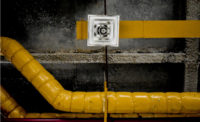So here we are, eight months into the largest change agent to hit the built environment in the last 25 years (heck, maybe of all time). In just a few months’ time, the COVID-19 crisis has brought about years of change, disrupted the economy, accelerated shifts in how we do things, and created changes that will be with us forever.
As I have previously commented, COVID-19 has brought into sharp focus the need to harness and leverage our buildings' digital infrastructure and has created a newfound urgency on how facilities need to be operated and managed. We are beyond seeking a way to build our way out of the crisis; we are now building our way out.
With eight months into this disruption, here are some observations that have made an impact on me (in no particular order):
- Trust is now considered to be a new building asset.
- COVID-19 has forced building control systems to become more functional.
- You must be able to quickly pivot along many fronts.
- COVID-19 has forced us to focus on human wellbeing.
- COVID-19 has revealed the importance of resiliency.
“Resilience is a key requirement for all of our institutions during these trying times, but we take a broad view of resilience as the ability to move beyond simply responding and recovering from unexpected challenges and instead finding ways to grow and evolve so that we can create even more value in the future. Rather than simply “bouncing back” to where we were before, let’s find new ways to connect our activities and help us thrive”. Deloitte
Hello Dynamic Workplaces
Traditional workplaces are emerging from this pandemic permanently altered. There is an increasing wave of analysis and opinion in support of a fundamentally altered workplace model that will include working from home, offer more choices, and even be more geographically distributed.
Not too long ago, many companies doubted Americans ability to work from home in mass, but, today, work from home is a worldwide reality. There is still improvement needed to provide the right experience and ways for smaller companies to get there with lower investment, but we are driving in this direction more and more. I expect companies will divest their office space square footage and instead invest in remote working technology. Where you live will not have much to do with where you work.
"Our offices will become a place where we gather as we will be giving our employees the flexibility to work from anywhere," said one Fortune 50 CIO.
And, Warren Buffet is quoted as saying, “The supply and demand for office space may change significantly. A lot of people have learned that they can work at home, or that there’s other methods of conducting their business than they might have thought from what they were doing a couple of years ago. When change happens in the world, you adjust to it.”
CDC Recognizes Airborne Transmission
There is growing evidence that droplets and airborne particles can remain suspended in the air, be breathed in by others, and travel distances beyond 6 feet (for example, during choir practice, in restaurants, or in fitness classes). In general, indoor environments without good ventilation increase this risk.
Indoor Air Quality (IAQ)
This global pandemic has shined a spotlight on the importance of IAQ, which is the most important factor in building health right now. Something we cannot see that has the potential to harm us now lurks in the air we breathe. While indoors, we are 20 times more likely to come into contact with it.
Jobs
The mix of jobs that emerge from this pandemic will be different than those that were lost.
Retail
We have seen the retail sector encounter an experience the likes we have not seen before; however, there have been bright spots. Stores such as Five Below, Dollar Tree, Lidl, and Tractor Supply, to name a few, are continuing with store expansion and new store opening plans.
Accreditation
Embracing accreditation programs to help facilities respond and recover is on the rise. In addition, it creates that all important “trust” factor. For example, the Kansas City Chiefs’ Arrowhead Stadium has achieved GBAC STAR™ accreditation along with a range of other commercial facilities.
Toilets, Yes Toilets
It’s time to talk about toilets and how they may be spreading covid-19.
And speaking of toilets, here is a list of America’s top restrooms for 2020 courtesy of Cintas Corp. and its 10 finalists for the 2020 America’s Best Restroom® contest. (Who knew!)
Digital Transformation
Digital transformation resulting from COVID-19 has emerged as the No. 1 priority of many of today’s top executives. Since the start of COVID-19, adoption of digitization and automation technologies has accelerated.
For many years, companies have talked about the digital transformation of buildings and facilities; however, many of those companies were not effectively pushing to accelerate those transformations. They probably thought they had enough time to deal with the market changes and handle the transformation in a controlled manner.
This has drastically changed over the first three quarters of this year. When we think of 2020, it is almost like thinking of a fast-forwarding year, where so much has been taken from us and not much has evolved. However, the acceleration seen in so many industries is unbelievable when we compare it to where companies were one year ago. This includes ours, the built environment. This has uncovered a whole world of new technological possibilities, which will likely keep evolving at a much faster pace.
To highlight this, take a look at McKinsey’s global survey of 800 executives. It suggests that a disruptive period of workplace is upon us due to acceleration of automation, digitization, and other trends. Since the start of COVID-19, executives say adoption of digitization and automation technologies has accelerated. In fact, the survey states that the majority of CEOs noted the COVID-19 pandemic has accelerated their digital investments and progress across numerous dimensions by at least a matter of months.
Unlikely Investors
Unlikely investors have become the new investors. For example, Simon Property Group and Brookfield Property Partners (mall owners) made a deal to purchase J.C. Penney out of bankruptcy.
Occupant Experience
There has long been a rush to find ways to enhance the service of an office building to include more than just a space to work but to enrich the experience and empower the occupant. A major step forward has been the proliferation of occupant experience apps. There is no doubt the pandemic has accelerated the delivery of these applications.
Sobering Thought
The person who manages your building has a bigger impact on your health than your doctor. Think about that.
Special Recognition and Thank You
Hats off to the NFL, NBC, CBS, Fox, and ESPN not only for their outstanding coverage, incredible camera angles, and outstanding play-by-play but also to their sound effects and making it seem the stadiums are full with real-life fans and creating the experience we have known in watching games.
Final Words
In the eight months of COVID-19 that have passed, technology has stood out as one of the key factors to recovery. We have all had to change, adapt, adjust, and get to know the new “new.” When it comes to technology, it has transformed companies forever. It must be driven by outcomes. Technology has given us the means to change the way we work, live, and meet in such a fundamental way that we will never go back. It has also changed the way we operate and manage commercial buildings and real estate.
This article first appeared in the November issue of www.automatedbuildings.com. See the article in its entirety at http://www.automatedbuildings.com/news/nov20/articles/marc/201009010301marc.html.





